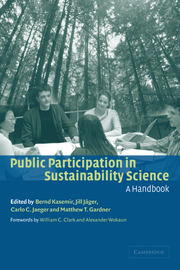Book contents
- Frontmatter
- Contents
- Notes on contributors
- Foreword: science, participation, and sustainability
- Foreword: sustainability, energy use, and public participation
- Preface
- Acknowledgments
- Part I Concepts and insights
- Part II Experiences with IA Focus Groups
- Part III Further forms of participation
- Introduction
- 7 Venture capital and climate policy
- 8 COOL: Exploring options for carbon dioxide-reduction in a participatory mode
- 9 Expert stakeholder participation in the Thames region
- 10 On the art of scenario development
- Part IV Future perspectives
- References
- Index
10 - On the art of scenario development
Published online by Cambridge University Press: 22 September 2009
- Frontmatter
- Contents
- Notes on contributors
- Foreword: science, participation, and sustainability
- Foreword: sustainability, energy use, and public participation
- Preface
- Acknowledgments
- Part I Concepts and insights
- Part II Experiences with IA Focus Groups
- Part III Further forms of participation
- Introduction
- 7 Venture capital and climate policy
- 8 COOL: Exploring options for carbon dioxide-reduction in a participatory mode
- 9 Expert stakeholder participation in the Thames region
- 10 On the art of scenario development
- Part IV Future perspectives
- References
- Index
Summary
Background
The only relevant discussions about the future are those where we succeed in shifting the question from whether something will happen to what would we do if it did happen.
(Arie de Geus, Former Head of Group Planning, Shell International)In a global environment of rapid economic, technological, and social change, scenario analysis is increasingly being seen as a key aid to the decision-making process in many organizations. A study of this relatively young methodology shows a wide spectrum of views on many of the fundamentals involved and with major differences in the development process used. A key issue in scenario development is to find the right balance between formal models with quantitative information and narrative elements that address “soft” issues like social values. Also, the key dissemination process is still inadequate in many cases, and there is a danger that if the technique is not used in an effective manner, confidence will be eroded and widespread use of a valuable aid will be curtailed.
As the world became a less certain place in the late 1960s and early 1970s, organizations began experimenting with scenario analysis as a method of gaining insights into the way the world might evolve. This method took root when the large oil price rises in the 1970s ensured the world had undergone a fundamental change, the scale of which shook the confidence of governments, policy-makers and private industry to plan effectively.
- Type
- Chapter
- Information
- Public Participation in Sustainability ScienceA Handbook, pp. 201 - 212Publisher: Cambridge University PressPrint publication year: 2003

